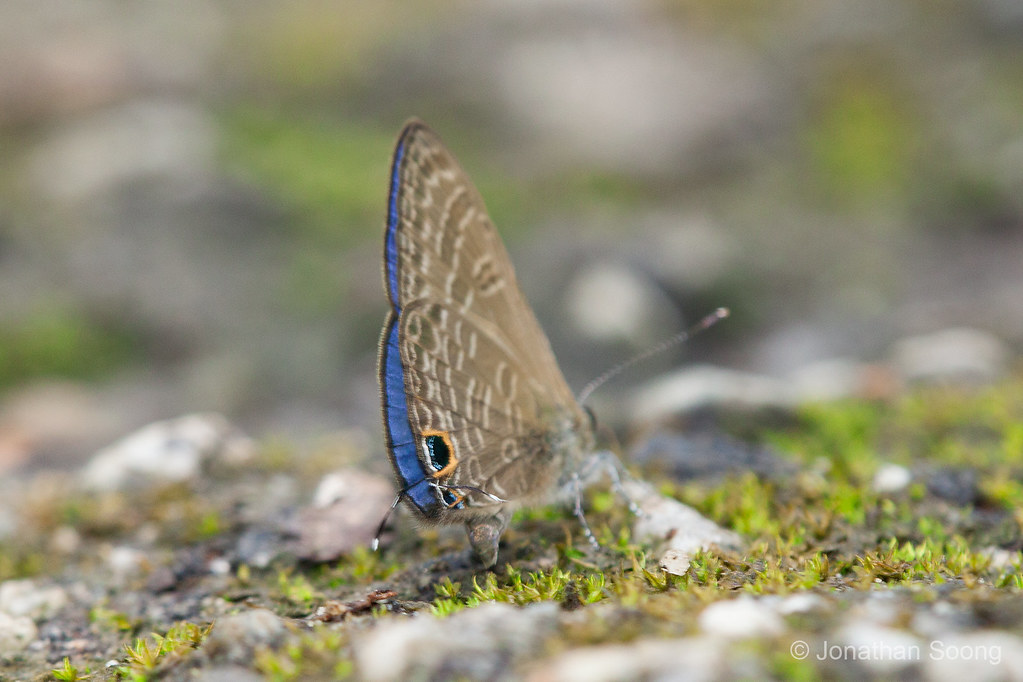Hmm. Comparing the N. beroe male and the N. berenice, it is still apparent that the dark striae are less developed in beroe.
Also, you're quite right I missed out N. kurava... I completely forgot about it!I'll try and get a shot next time.
Hmm. Comparing the N. beroe male and the N. berenice, it is still apparent that the dark striae are less developed in beroe.
Also, you're quite right I missed out N. kurava... I completely forgot about it!I'll try and get a shot next time.
cheers
Jonathan
The first one is Ionolyce helicon. The wing shape and the post-discal striae on the forewing in space CuA1 give it away. I've shot many of these hoping that one of them would turn out to be N. beroe. N. beroe seems rare- i've not seen one yet.
Aaron Soh
Aaron, Dr Seow, I believe this is the next fourline-blue on our list: Nacaduba hermus.
Upperside is violet-blue.
ID confirmed as Nacaduba hermus

Last edited by Banded Yeoman; 20-Aug-2019 at 06:56 PM.
cheers
Jonathan
Yes, it can only be hermus. What an exciting find! Pretty soon you'll probably get a clear shot of N. pendleburyi to complete the rarer four-lines
USR?
Aaron Soh
Wonderful! You got it right.
There are several species recorded from Singapore in the past.
Nacaduba 4-lines with the dark striae absent or weak.
A. HW with the marginal & submarginal spots wider apart. 1. N. sanaya & 2 .pendleburyi.
B. HW with the marginal & submarginal spots near to each other 3. N. subperusia & 4. N. hermus.
N. hermus : HW black spot with metallic scales.
http://www.ifoundbutterflies.org/med...gale_ab589.jpg
N. subperusia ;HW black spot without metallic scales.
http://3.bp.blogspot.com/-CCzm1ZlQsQ...rusia+lysa.jpg
TL Seow: Cheers.
Aaron, Dr Seow,
I've been shooting lots of alea-subgroup Arhopala recently and several of them have had much wider fw post-discal bands. This one male which I tracked gave me a glimpse of the upperside, showing the fw border increasing in width towards the apex. The fw termen is also revealed to be evenly curved from the upperside.
To cut to the chase, I think this is Arhopala selta.

Last edited by Banded Yeoman; 10-Jul-2019 at 10:16 AM.
cheers
Jonathan
The border is definitely increasing in width but i'm not sure if this is wide enough for selta. Unfortunately this is a very poorly known group and there's very little information online and i don't have my references with me, so i'll let Dr Seow have a say
Aaron Soh
Agreed it is Arhopala selta..
You have very clear shots of both surfaces ,so there is no ambiguity.
Thus it meet all the criteria.
1. UpF border increases towards the apex.
2. HW postdiscal spot 6 overlaps the cellend bar by half.
3. FW termen somewhat rounded.
Whether the FW postdiscal band is always relatively wide is hard to say.
Perhaps A. phaenops also occur in Singapore.
In the thread below, the male have a straight termen , the UpF border appears to be broad at the apex, & HW spot 6 barely overlaps the cellend bar.
Only the males of selta & phaenops have the UpF border increas at the apex.
All other males have the FW border a thread throughout.
http://www.butterflycircle.com/showt...rhopala-for-ID!
A male labelled as A. sublustris from Cambodia for comparison.
https://farm5.static.flickr.com/4564...44eda5c2_b.jpg
TL Seow: Cheers.